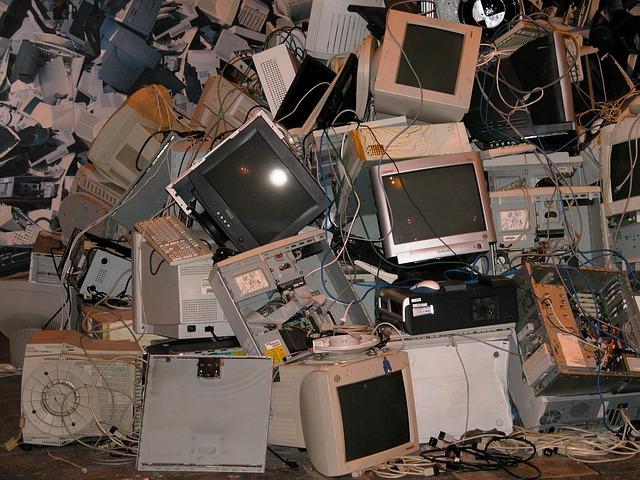Around 1.5 billion smartphones are sold globally every year. And the number keeps increasing. And along with the growing number of electronic devices, come a growing number of impacts. E-waste or electronic waste is a global problem that keeps growing every year. And fixing it can be very difficult.
Once smartphones, computers, monitors, tablets and everything internet of things devices are thrown out, they become e-waste. And the world is generating a lot of these at an alarming rate. More than 50 million metric tons of e-waste are produced every year and it keeps growing.

Americans throw away an estimated USD 55 billion in electronic waste material annually. The World Health Organization is warning that the amount of hazardous scraps around the world is growing significantly. Electronic junk is made up of a lot of different materials that once welded together can be difficult to recycle.
People get rid of their computers every three years maybe, they get rid of their phones about every two years, just multiply that by every human on earth, you get a very large mountain of digital waste. And approximately 70% of electronic scrap is unreported and its ultimate destination is unknown. Electronic rubbish is the fastest-growing source of toxic waste in the world.
Despite contributing to only about 0.01% to 3% of total scraps, digital waste is growing twice as fast as other forms of scrap. China used to accept about 70% of the world’s e-waste. But has now banned 24 types of solid waste, including e-waste. This decision has helped countries like the U.S. recognize that they have a problem. China bans e-waste in a bid to protect its environment.
Computer manufacturing requires about 240kg of fossil fuels, 21kg of chemicals and 1.5 tons of water. The process of burning these materials creates toxins. According to a recent United Nations University report, the global production of e-waste reached 41.8 million. Only one-sixth of this scrap is recycled.
In 2014 nearly 60% of old electronics were dumped into landfills, the other 40% were recycled and 25% of that was shipped to developing nations. The World Economic Forum estimated e-waste could contain more than USD 62 billion worth of precious metals. By recycling 1 million cell phones more than 15,000kg of copper, 14kg of palladium, 350kg of silver and 34kg of gold can be recovered.
These materials are not only worth money but recovering them can also help reduce the amount of mining necessary. Hence reducing the impact on the environment. However, while wealthy countries generated much of this waste, developing nations are often left with the task of recycling it.
The global recycling rates of electronic scraps are extremely low, with the EU leading the way. Only about 35% of electronic junk is collected and a further 20% goes undocumented. Even more worrying, the materials in these electronic are not biodegradable. This makes them an environmental disaster.

The issue of E-waste recycling is particularly exhausting and difficult. This is why most facilities are located in low-income areas. When disposed of in a landfill, it often contains toxic substances that leach from the materials they contain. People living in these communities are exposed to a variety of toxic chemicals. These chemicals are also absorbed into the environment through the inhalation of dust or contact with soil.
Electronic scrap is also a potential source of contamination for water and food. Some of these chemicals are toxic to people. This type of pollution is particularly harmful to communities near landfills since these toxins can endanger humans and animals who depend on these bodies of water.
To date, there has been some recycling of the valuable elements contained in electronic waste such as copper and gold. However, these are often extracted using fairly primitive methods such as burning cables to remove the plastic and extract the copper. These methods expose workers who are often children to toxic fumes.
Some countries recycle electronic scraps by burning circuit boards or soaking microchips in acid to extract gold silver and copper. Workers are often exposed to toxic metals like lead, mercury, cadmium, and beryllium. The danger produced from e-waste may come from direct contact with these harmful materials or the inhalation of toxic fumes.
Although the disposal of electronic junk presents serious risks to human health, this practice remains a key source of survival for the urban poor in developing countries. If e-waste management is not improved, the consequences can have a devastating impact on the health of the region. Further research is needed to understand and mitigate the impact of electronic waste.
According to the institute of physics, the huge amount of lead in e-waste when released into the environment could cause severe damage to humans. Children and women are typically the ones who take part in the recycling process and this is often an informal means of income.

So what can you do to combat e-waste, you can sell or donate old electronics or maintain electronics properly so they last longer. You can recycle and dispose electronics properly, like before buying new devices consider repurposing an old one. However, it is hard to follow these rules because nowadays electronics are made to be replaced.
Many people aren’t aware of the best ways to recycle electronic scraps and instead simply toss them in the trash. Many cities now offer programs to collect and recycle electronic junk as well as to exchange used devices for gift cards. Other ways to dispose of them include donating them to charity or selling it for a profit.
Companies use a method called planned obsolescence. Where a product has a limited useful lifespan and becomes outdated quickly. Hence, tackling the problem will take more than disposing of electronic waste properly or recycling them in developing nations.

0 Comments